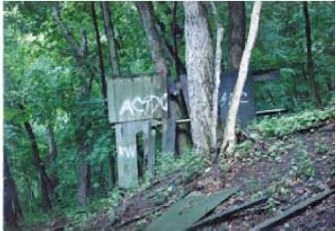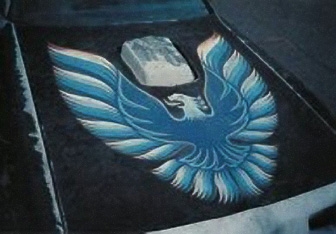Feature: Reviews
Justin Walsh: Signs of Real Life
- Jack Hanley Gallery
- San Francisco
- August 9 - September 1, 2001
Justin Walsh’s photographs remind us of a time when desire, romance, and revolution were enough to classify a photograph as art. His first solo show at Jack Hanley Gallery does not play with the idea of photography as a fictive medium able to create realities, the viewing of which poses complex questions about how we think, how we ascribe meaning, how we define the real, and how we inculcate norms and collective signs. Walsh’s photos simply record life to reveal formal, emotional, or existential truths.
Walsh’s work communicates through the themes of rock culture, kitsch objects, interiors of residential hotels, and portraits of kids who create lives around this stuff. These are the sorts of things that are easy to fall for since they are all but abandoned and call out to be noticed. This is the land of Larry Clark, Nan Goldin, even Edward Hopper, a place where an artist prowls looking for signs of real life with its complex mix of glamour and pain.
The most compelling example of Walsh’s romantic take on documentary photography played out in a wall-size image of an abandoned tree house that had been tagged with the name of the seminal metal band AC/DC. The tree house, clearly hand-built from scraps of wood, was awkwardly nestled in a tree and splattered with paint. It loomed over viewers along with details from the surrounding forest, positioning us beneath what became a sublime, almost mystical chapel of heavy metal music. This is a photograph of a site as pitiful as it is beautiful. That this image of something so formally unremarkable could contain such power is an example of Walsh’s ability to manipulate light, color, and composition to reveal something that one could call truth.
On another wall were three smaller photos depicting three different male teenagers who either faced the viewer directly or turned away, coolly staring off into an open expanse. Looking at these kids, we are aware that they express a kind of coolness that many of us desired in our own youth, when we wanted to have our own way of standing, wearing our hair, and dressing. Perhaps like the vulnerable young men in these photos, we hoped to be sexy and used our instincts to achieve that end in a world that we had no say in shaping. Looking at Walsh’s portraits, we can begin to imagine these teens hanging out in the tree house in the other image, listening to the soundtrack to a rebellion about sex and fun and music.
Other images in the show were felt less strongly, but they revealed Walsh’s romance with isolated objects: the firebird on the hood of a Trans-Am, a poster left on the dirty wall of a seedy hotel room, a roll of toilet paper cloaked in a handcrafted yarn hood. As details culled from the real world and as symbols of the lower parts of culture, these pictures effectively communicate a sense of abandonment without pointing fingers or citing a cause. We view them like the teens in the other photos, for Walsh makes us painfully aware of their future by making us so knowledgeable of their present condition. Each of Walsh’s photos communicates his passion for his subjects without irony. He is adept at focusing our attention on common objects in a way that sends us out into the real world looking for instances of the tender, the beautiful, the sublime.
With this exhibition, Walsh makes a strong first step into the art world using images of low culture to aid a devastating and precise search for the real. His symbolically loaded images are evidence of an artist wishing to make meaningful work from what already exists in a culture that privileges the glossy and new above all else.
Justin Walsh was on view at the Jack Hanley Gallery, 395 Valencia Street, San Francisco. For more information call (415)522-1623 or visit www.jackhanley.com.


